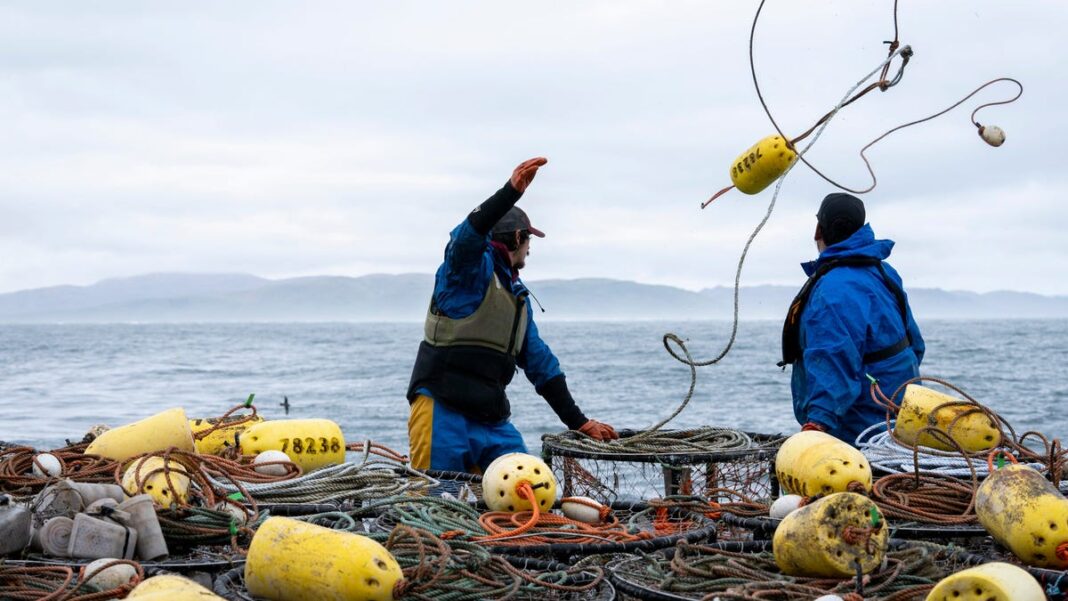California crabbers face a major issue: Season launch postponed yet again
SAN FRANCISCO – The Dungeness crab from California, which is a favorite during holiday festivities for numerous families on the West Coast, has encountered another delay in its fishing season.
Once again, access to this will likely remain limited until early December or potentially even next year.
This marks the sixth consecutive year that the state’s Department of Fish and Wildlife has postponed the beginning of the commercial crab fishing season along much of the coast. This decision is aimed at safeguarding endangered humpback whales from becoming ensnared in vertical fishing lines, which can lead to serious injuries or fatalities.
Dungeness crabs are highly valued by locals for their size, flavor, and abundance in California compared to other crab varieties.
As well as being enjoyed by locals, these crustaceans are a popular choice for visitors at San Francisco’s Fisherman’s Wharf. They are mainly located in the central and northern areas of California.
Shifting the start date from the typical November 15 to no earlier than December 1, and possibly even later, means that fans of this seasonal treat may miss out on it before Thanksgiving. More critically, this decision negatively impacts a fishing industry that is already struggling after the cancellation of the last two ocean salmon seasons due to dwindling fish populations.
“We’re having to minRichard Ogg, who heads an advocacy group along the Sonoma County coast near San Francisco, stated, “We try to adjust our fishing schedules according to the migration habits of these specific animals. While it’s something no one enjoys doing due to its significant financial implications for us, we believe it is crucial as fishermen to safeguard these creatures.”
Allowing Humpbacks Time for Their Southern Migration
The postponement aims to give humpback whales sufficient time to journey south. This decision has been made in consideration of their natural migration patterns and the challenges they face during this period.
It’s that time of year again when whales begin their migration south for the winter after accumulating fat reserves by feeding along the coast.
This month, surveys carried out by the DFW in five out of six fishing areas in the state recorded 99 humpback whales one day within the zone around San Francisco, and 73 on another day in the neighboring zone to the south that includes Santa Cruz and Monterey.
In a region where a threshold of 20 has been established, there is now a delay affecting the start of the season.
Additionally, from May 17 to October 20 this year, the DFW noted 14 incidents of whales getting entangled in fishing gear. Four of these cases involved commercial crabbers—one more than the limit that would typically lead to an early end to the season. As a result, the last two seasons were concluded in April rather than June as usually expected.
The department’s Risk Assessment and Mitigation Program, which was launched in 2020, includes various measures designed to tackle the rise in injuries suffered by humpback whales due to fishing gear.
This regulation became necessary after a notable increase in whale sightings along the coast. This spike occurred following a marine heat wave from 2014 to 2018, which seemingly drove their food sources—like sardines and anchovies—closer to shore, prompting the humpbacks to follow suit.
Ogg, who is part of the state’s Dungeness Crab Task Force—a group that evaluates management strategies—notes that the humpback population has been on a consistent rise over recent years,
Commercial fishermen in California will face restrictions on their activities until at least December 1, and possibly even longer, due to concerns that their fishing gear could pose a threat to humpback whales.
What is the start date for the Dungeness crab season?
The whales remain under protection, raising the question of when they will migrate back to their winter habitats along the Pacific coast of Mexico and Central America. This year’s crab season was delayed until January 18, with catch limits imposed even at that time.
“These animals seem quite content,” Ogg remarked. “There’s an abundance of anchovies and food near the shore. So, will they leave soon? Most likely not.”
Ryan Bartling, a senior scientist at the DFW, shares this view. He often receives inquiries on this subject and has a standard response ready.
“I usually say to people, ‘Only the whales can determine when they will leave.’”
“When we analyze past seasons, we often find that whales remain in the region until late December,” said Bartling. “This trend has led us to consider starting the season later.”
The Department of Fish and Wildlife (DFW) will reassess the situation regarding entanglements and humpback whale populations near fishing zones. An update about a potential opening date is expected around November 15. This delay only impacts specific areas, as Dungeness crabs are still being harvested in Oregon and Washington.
As the number of whales increases, there’s a corresponding rise in entanglements. The department is focused on protecting these whales while considering the needs of crab fishermen.
“The delays are our best attempt at trying to find the right balance,” he explained. “We aim to allow crabbers access to the water as soon as we can, while also reducing interactions with most of the humpback whales during their stay.”

